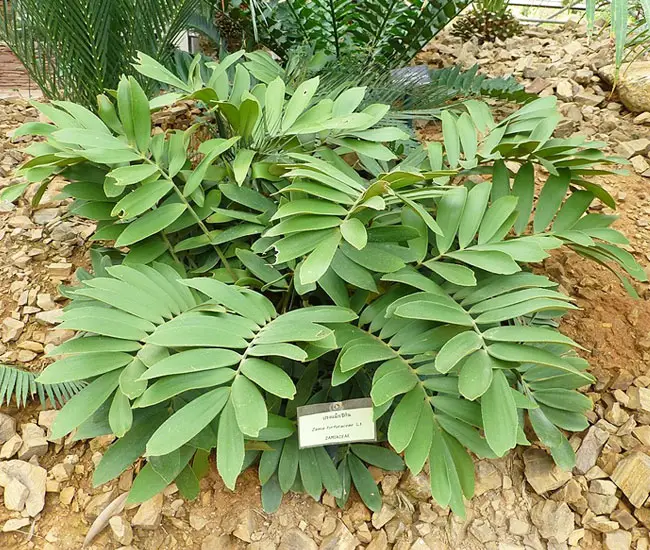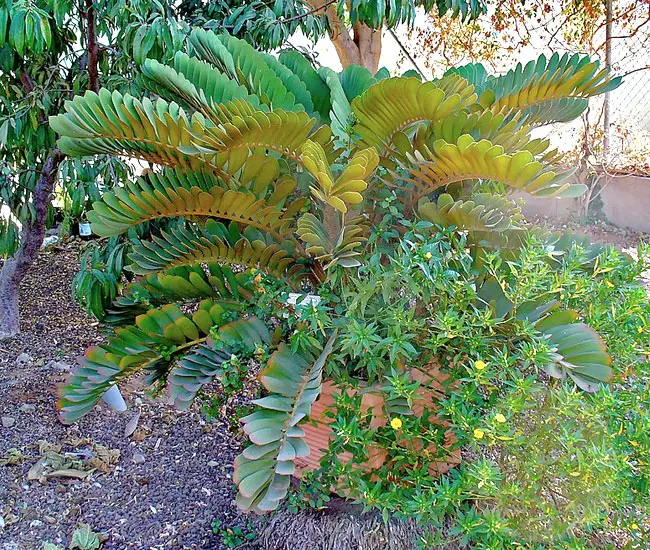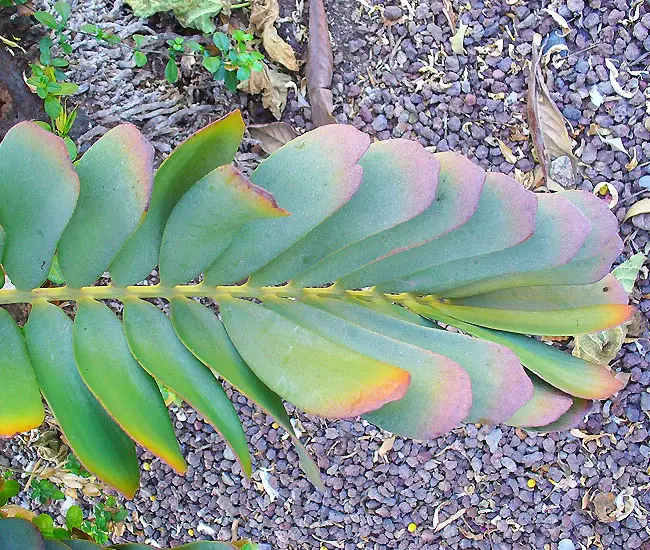
The Cardboard Palm (Zamia furfuracea) is a unique and fascinating cycad native to Mexico. Its striking appearance is characterized by stiff, fern-like, bright green leaves that are often described as having a cardboard-like texture, hence its name.
This plant is not a true palm but rather a cycad, which is an ancient group of seed plants. The Cardboard Palm is a slow-growing and long-lived species, with some specimens known to live for centuries.
It produces large, cone-like structures that house its reproductive structures, which are toxic if ingested, making it unsuitable for consumption by humans and pets. Despite its tropical appearance, the Cardboard Palm is adaptable to a range of climates and is often used as an ornamental plant in gardens and landscapes worldwide.
Quick Facts:
| Scientific name: | Zamia furfuracea |
| Common names: | Cardboard Palm, Cardboard Plant, Cardboard Sago, Cardboard Cycad, Jamaican Sago, and Mexican Cycad. |
| Origin: | Native to Mexico. |
| Growth Rate: | Slow. Up to 5-10 ft tall and 1-5 ft wide. |
| Cold Tolerance: | USDA Zones 9a (20 to 25 F) to 11 (above 40 F) |
| Light Req: | Partial shade to full sun. |
| Water Req: | Drought tolerant. |
| Soil Req: | Well drained sandy soil. |
| Fruit: | Yes. Not edible. Toxic for pets. |
| Propagation: | Propagated by seeds. |
Cardboard Palm Appearance
Zamia furfuracea, commonly known as the Cardboard Palm, features a short, thick, fleshy trunk enveloped by old leaf bases. This unique trunk design allows it to collect and store water for use during drought periods. The Cardboard Palm’s distinctive pinnate leaves emerge from the central trunk and can reach lengths of 3 to 4 feet.
These olive-green leaves are notable for their overlapping arrangement and possess a fuzzy surface, lending them a texture resembling plastic or cardboard, which gives rise to their common name.
The circular crowns of leaves form a symmetrical rosette, resembling a fusion of fern and palm tree, with their orientation being upright in full sun and horizontal in shade. The leaves themselves are thick and adorned with oval leaflets measuring approximately 5 inches in length and 1 inch in width.
Flowers and Fruits of the Cardboard Palm

The Cardboard Palm produces distinctive cone-like structures that house its reproductive features. These structures, while visually intriguing, are not considered true flowers. Instead, they contain the plant’s male and female reproductive components.
The Cardboard Palm’s reproductive cones can be found among its foliage, serving as the reproductive organs of this ancient plant species. These cones, often referred to as “strobili,” are typically produced on mature plants that have reached a certain level of maturity, usually around 5 to 6 years of age.
As for the fruits, they emerge following successful pollination of the female cones. These fruits are characterized by their small size, typically measuring approximately 1/5 inch in length.
The fruits begin as green and gradually transition to a reddish or dark hue as they ripen. While these fruits may add a touch of color to the palm’s appearance, it’s essential to note that they contain compounds that can cause skin irritation. Consequently, they are not suitable for consumption by humans or pets.
How To Care For Cardboard Palm
While younger specimens of the Cardboard Palm exhibit slower growth rates, their pace accelerates after the formation of a trunk. Typically growing in clumps, this palm can attain heights ranging from 5 to 10 feet and spreads 1 to 5 feet in width.
The Cardboard Palm Tree is highly favored as a houseplant due to its ease of cultivation and maintenance. When grown indoors, it requires ample sunlight during its growth periods, which usually occur once or twice a year, predominantly from March to June.
Regarding its cold tolerance, the Cardboard Palm is considered hardy, capable of withstanding temperatures as low as 20°F, albeit with potential leaf damage occurring around 28°F. This makes it suitable for cultivation within USDA Hardiness Zones 9a (with temperatures ranging from 20 to 25°F) to 11 (above 40°F).
The Cardboard Palm displays drought tolerance and does not necessitate frequent watering. It thrives in moist, well-drained soil, with its trunk acting as a reservoir to store water during dry spells. To prevent root rot, it is essential to avoid waterlogging.
For optimal growth and to prevent nutritional deficiencies, applying a high-quality palm fertilizer with a continuous-release formula twice a year during the growing season is recommended.
Cardboard Palm Propagation
Propagation of the Cardboard Palm is primarily achieved through seeds, and they should be sown as needed, as they do not store well. When handling the seeds, precautions should be taken to prevent skin irritation from the fruit’s juice.
Planting the seeds in shallow containers filled with a mixture of 50% peat moss and 50% perlite, with only slight covering, is advisable. Maintaining consistently moist conditions is crucial for successful germination.
As seedlings reach heights of 5 to 6 inches, they can be transplanted into 4 or 6-inch containers filled with a well-draining potting mix, with fertilization commencing immediately. Young plants benefit from partial shade, transitioning to full sun as they mature.
Cardboard Palm Pictures










More information can be found on Floridata site.

Comments are closed.